
Are lemmings turning the Arctic green?
Just when lemmings have finally lost their unwarranted reputation for throwing themselves off cliffs, now they are being blamed for climate change.

Researchers found that large populations of lemmings are turning the Arctic green as the herbivores graze on plants and fertilise the soils.
But for all it appears the the retreat of Arctic the tundra is encouraging global warming it may actually cool down the climate as plants can grow bigger and store more carbon.
The team from the University of Texas at El Paso found when lemmings are excluded from the Arctic environment in enclosures in Alaska there is an increase in certain plant types called lichens and bryophytes.
However when the lemmings were present there were surprising increases in grass and sedge, the plant material that lemmings actually feed on.
Dr David Johnson, lead author of the study, said the paper shows the impact the lemming population has on the local ecosystem and even the climate.
Populations of lemmings are well known for a dramatically fluctuating population, like rabbits, and thousands can take over an area very fast before diminishing to virtually nothing.
“Our paper confirms that we really need to be careful attributing the greening of the Arctic to global warming alone. We have shown that lemmings can promote similar greening, through the increase of grasses and sedges, as warming does in Arctic regions where lemmings are present and go through dramatic population cycles.”
Satellite imagery has already confirmed that Arctic regions are becoming covered with grasses and shrubs, as increasing temperatures make the areas more habitable.
However no one knows if the greening of the Arctic will cause global warming or cooling.
Dr Johnson said the increasing plant matter could reduce global warming as bigger plants absorb more carbon. On the other hand soil decomposition increases with warmer temperatures meaning soil microbes are respiring and releasing carbon into the atmosphere and potentially increasing climate warming.
“We still don’t know the relative magnitude of these two feedbacks to warming. A greener landscape may maintain the region as a carbon sink, however higher plant growth in a greener landscape may not be enough to offset losses of carbon from soil microbes. It is plausible that herbivores, in some situations, may provide a mechanism for higher plant growth maintaining these ecosystems as carbon sinks.
“We are not saying that lemmings are causing the greening, because greening is occurring in areas where lemmings don’t occur at high densities and we are not sure how lemming populations across the Arctic are themselves responding to warmer conditions. However, it is clear from our study that lemmings, and other herbivores, are more important in some of these Arctic ecosystems than people historically give them credit for,” he said.